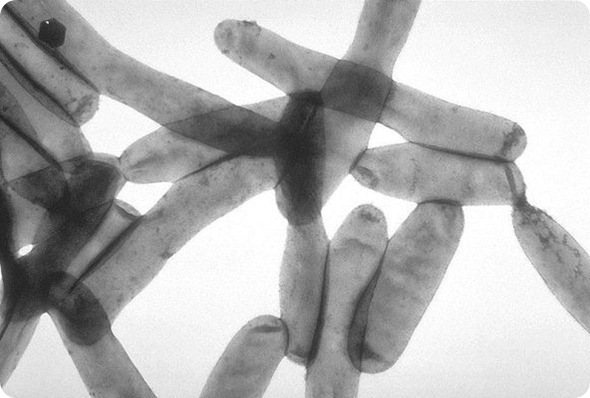Diagnosis and treatment of Legionnaires’ disease
Legionnaires’ disease is caused by bacteria of the legionella species. Legionellosis includes the severe pneumonia causing Legionnaires’ disease as well as the milder non-pneumonic Pontiac fever.
Both conditions begin similarly as flu like illness with fever, body ache, muscle pain and headaches. Within a day of two patients with Legionnaires’ disease worsen.
Those with Pontiac fever however may progress with resolution of the disease by itself 5 to 7 days. Legionnaires’ disease usually may persist for weeks and worsen to cause kidney, respiratory or multi-organ failure.
Death is seen in 10 to 15% of those infected with the organism Legionella pneumophillia. Thus identification of the condition and early institution of therapy is vital to prevent death. (1-4)

TEM image of L. pneumophila. Image Credit: CDC
Physical examination of Legionnaires’ disease patients
Physical examination of a Legionnaires’ disease patient shows high rise of temperature, rapid and shallow breathing, relative slowing of heart rate etc.
On examination of the chest there may be abnormal sounds picked up by the stethoscope called rales, ronchi and crepitations indicative of pneumonia.
Liver enlargement and alterations in mental status may be observed.
Screening for Legionella infection
All patients with pneumonia need to be screened and evaluated for legionella infection. The sputum, respiratory secretions, blood and urine samples are examined for the organism.
Another test called the indirect immunofluorescent antibody test (IFAT) reveals L. pneumophillia infection by showing high rise of antibodies that the body prepares against the infective organism.
Other tests for Legionnaires’ disease
Other tests like complete blood count reveals high white blood cell count, low sodium levels in blood, high blood levels of creatinine, low levels of enzyme Alkaline phosphatase etc. Arterial blood gas analysis shows increased carbon dioxide and decreased oxygen in blood. Chest X ray reveals pneumonia in the lungs.
Other diagnosis that may be considered include other microbes causing pneumonia, heart failure or Severe acute respiratory syndrome (SARS).
Antibiotics for Legionnaires’ disease
The condition is usually treated with antibiotics that kill the organism. Common antibiotics used include:
- Erythromycin
- Azithromycin
- Clarithromycin
These are taken as pills by mouth. In more severe cases they may be given through an intravenous infusion.
The antibiotics are usually advised for 7 to 10 days but in some cases the course of antibiotics may last up to 3 weeks.
Common side effects of these antibiotics include:
- nausea
- vomiting
- dizziness
- diarrhea
- loss of appetite
- drowsiness etc.
Alternate antibiotics are Doxycycline, Tetracycline, Ciprofloxacin and Pefloxacin. These drugs may also require a 10 to 21 days therapy.
Drugs like Erythromycin, Azithromycin, Clarithromycin, and those like Ciprofloxacin, are often first line of drugs that are used in Legionnaires’ disease. Penicillins and similar drugs are ineffective in Legionnaires’ disease.
Treating fever and muscle pain associated with Legionnaires’ disease
High temperature and muscle pain may be treated with Paracetamol (Acetaminophen) or with other pain relievers.
Hospital admission for Legionnaires’ disease
Patients with risk factors like other long term illnesses like kidney or lung disease or diabetes are usually conditions that necessitate hospital admission. This is particularly so in case of elderly patients.
Oxygen is given via nasal tubes or via a mask to help breathing. Intravenous fluids are given as infusion via a needle in a vein in the arm to prevent dehydration.
Heart rate, blood pressure and other vitals are closely monitored and regulated if necessary. In case of respiratory failure patients may need ventilator support for breathing.
Sources
- http://www.nhs.uk/Conditions/Legionnaires-disease/Pages/Treatment.aspx
- www.patient.co.uk/doctor/Legionella-and-Legionnaires'-Disease.htm
- http://www.who.int/water_sanitation_health/emerging/legionella.pdf
- http://www.publish.csiro.au/?act=view_file&file_id=NB07033.pdf
Further Reading
- All Legionnaires' Disease Content
- Legionnaires’ disease – What is Legionnaires’ disease?
- Causes of Legionnaires’ disease
- Symptoms of Legionnaires’ disease
- Prevention of Legionnaires’ disease
Last Updated: Apr 19, 2019

Written by
Dr. Ananya Mandal
Dr. Ananya Mandal is a doctor by profession, lecturer by vocation and a medical writer by passion. She specialized in Clinical Pharmacology after her bachelor's (MBBS). For her, health communication is not just writing complicated reviews for professionals but making medical knowledge understandable and available to the general public as well.
Source: Read Full Article
